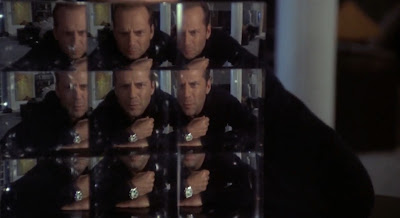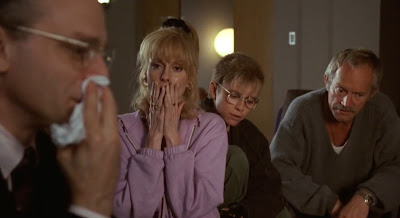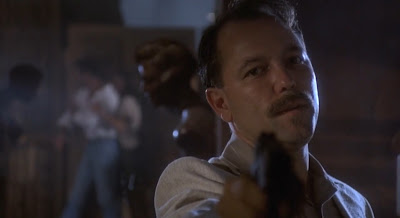 |
| Dr. Bill Capa (Bruce Willis) gets involved with a troubled young woman (Jane March). |
Release Date: Aug. 19, 1994. Running Time: 121 minutes (theatrical), 139 minutes (director's cut). Screenplay: Billy Ray, Matthew Chapman. Producer: Buzz Feitshans, David Matalon, Andrew G. Vajna. Director: Richard Rush.
THE PLOT:
After a patient commits suicide in front of him, psychologist Bill Capa (Bruce Willis) loses the ability to see the color red. Needing time to recover, he goes to Los Angeles to stay with his friend, Bob Moore (Scott Bakula), who became rich after the breakout success of his self-help book, Way to Go!.
All is not well with Bob. He has been receiving death threats, which he is convinced are from someone in his Monday therapy group, and he hopes that Bill can help him identify which of his patients is actually dangerous. Bill sits in on one meeting, but nothing really stands out... and before the next meeting takes place, Bob is brutally murdered.
With a little manipulation from police Lt. Martinez (Ruben Blades), Bill takes over the Monday group. He also begins talking to the patients one-on-one, trying to figure out what happened and who was responsible. He's only barely started investigating when he runs into Rose (Jane March), a beautiful young woman who refuses to reveal anything about herself - but who seems to be entangled with every member of the group...
 |
| Bill admires an art piece that reflects his own fractured state. |
CHARACTERS:
Dr. Bill Capa: Bruce Willis is well-cast as the traumatized psychologist. In the wake of his patient's death, Bill is cut off from his own emotions. This is a good fit for Willis's persona, as it actually creates an in-story reason for the sense that he's ironically observing his own actions. When he initiates the affair with Rose, he does so fully aware that she's too young for him. He even remarks at one point, when she arrives wearing a backpack, that it makes her look even younger than she already is. "Always guess the cliché, and you won't be disappointed," he quips.
Rose: Jane March was cast because of her performance in Jean-Jacques Annaud's The Lover, a movie that involved many explicit scenes. Despite this, she was uncomfortable with this film's nudity - I suspect at least in part because, while The Lover's sex scenes formed a major part of the character dynamics, Color of Night's were pure exploitation. Her performance is actually good despite some poor dialogue, and she manages a decent American accent. But the Razzies, in their ongoing inability to distinguish between bad acting and good acting in a flawed movie, still nominated her as Worst Actress.
Det. Martinez: Rubén Blades steals his every scene as the foul-mouthed lieutenant assigned to the case. When Bill seems reluctant to talk to the therapy group, he convinces him by giving an example of how tactful he would be in delivering the news: "Listen up, you f***ing daffodils, your shrink is dead!" Bill regards him with open disgust, which seems to be entirely reciprocated. The director's cut adds in a few extra character details, revealing the reason why Martinez wants to avoid direct contact with the group.
Dr. Bob Moore: Scott Bakula makes a solid impression as the ill-fated Los Angeles therapist. He and Bruce Willis are convincing in portraying the competitive side of the friendship between the two characters, and he projects enough intelligence for us to believe that he managed to figure out much of the mystery before his death.
The Therapy Group: The patients Bill inherits, played by some very recognizable 1990s character actors. Lesley Ann Warren is Sondra, a nymphomaniac/kleptomaniac. Brad Dourif is Clark, an attorney with OCD who compulsively counts every book in the office at every meeting (inevitably, this turns into a plot point). Kevin J. O'Connor is Casey, an obnoxious rich kid who fancies himself an artist.
The best performance not only of the group, but of the film, comes from Lance Henriksen as Buck, who is suffering from PTSD after witnessing the deaths of his wife and daughter. Henriksen doesn't overact, and so he holds our focus even when the others are screaming at each other. Two of the movie's best moments belong to him: a scene during a storm, with Buck's pain tangible as he relates the exact events leading up to his family's death; and a later bit in which he expresses his forgiveness for another character (though this only occurs in the director's cut). These scenes are well-written, and Henriksen wrings maximum emotion out of them precisely because he plays them with restraint.
 |
| The members of the therapy group react to news of their doctor's death. |
"SAY SOMETHING NICE":
Color of Night was Richard Rush's return to the director's chair for the first (and last) time since 1980's The Stunt Man. I think it's fair to say that it wasn't the movie anyone had been waiting for. That said, particularly in the director's cut, it is evident that Rush knows how to compose a shot and how to build a scene.
I've commented on other big studio Razzie winners by noting professional polish. Never mind "polish" - in its director's cut, Color of Night looks gorgeous. Shots are beautifully framed, with Rush making the most of every setting: Bob Moore's office, where the group meets; the expensive but coldly antiseptic house where Bill is staying; Buck's darkened living room, with the storm in the background; Casey's cluttered loft; a welder's garage. Every setting is atmospheric, and every shot is well-composed.
The story has its problems, even in the director's cut. Still, Color of Night is an extremely well-made movie.
Well, one version of it is, at least...
 |
| Bill and Rose stumble across important plot information - but only in the director's cut. |
THE UNKINDEST CUT
There are two versions of Color of Night: producer Andrew Vajna's 122 minute theatrical cut, and Richard Rush's 139 minute director's cut. These are more different than the usual theatrical/director split, because Vajna's cut is not a simple reduction of Rush's version. The two cuts were prepared entirely independently of each other.
Rush had been led to believe that he had final cut, but he did not. He remained determined to release his version, and both cuts were test screened before Vajna fired him. The Director's Guild of America stepped in and negotiated a settlement: Vajna's cut would be theatrically released, but Rush's would be the version distributed on home video. There's a lot more (some public nastiness from Vajna, Rush's possibly related heart attack), but that's the gist of it.
Vajna's cut hit theaters in August 1994... with disastrous results. The theatrical version removes vital character and plot information and rearranges scenes, all of which combine to create inconsistencies. Set pieces are not properly established, including the film's big car chase, and multiple threads are left dangling. Editing is more jagged, and shots within scenes don't flow into each other the same way they do in Rush's cut. The use of color is also different. Rush avoids red hues, reflecting Bill's affliction; he only allows red back into the lighting and flesh tones at the very end. Vajna does not do the same, which creates a noticeable visual difference.
For what it's worth, Richard Rush ultimately "won." The theatrical cut flopped miserably, while the VHS director's version topped sales and rental charts. For most of the time from then to now, Rush's version has been the primary one available. Even the 2019 Kino-Lorber blu-ray, which includes both versions, clearly makes the longer cut the main feature with the theatrical one more of an extended extra.
Streaming services are about 50/50 on which version you'll find: Vudu and Prime carry the director's cut, while YouTube and Apple TV carry the theatrical cut. Avoid the shorter version: The director's cut may not exactly be a good movie, but it's well made and enjoyable. The theatrical cut is just bad.
 |
| Bill is entranced by Rose. |
AN EROTIC THRILLER THAT SHOULDN'T HAVE BEEN:
Color of Night would have likely been a lot better if it had been made a few years earlier or a few years later. Unfortunately, it came to the screen in 1994, when producers were still trying to box every suspense movie into the "erotic thriller" genre to try to recapture the lightning-in-a-bottle success of Basic Instinct.
The sex scenes never feel like an integral part of the movie. The relationship between Bill and Rose is developed (such as it is) in dialogue scenes, while the suspenseful moments occur when Bill is investigating and/or being stalked by the killer. The sex scenes neither advance character dynamics nor build suspense. As a result, the pace gets bogged down by them.
This is particularly true of the mid-film sex scene, which seems to go on forever. Bill and Rose start off in a swimming pool, where the director's cut treats female viewers to a blink-and-you'll-miss-it shot of Little Bruce. Then they're in the bed. Then it seems to be over as they exchange dialogue while eating... Only for the film to go back to them in the shower. Then we dissolve to a shot of some hang gliders, a sure tip that we're about to get back to the story... Only we're not, because they're back in bed.
I will say that Bruce Willis and Jane March actually have reasonable chemistry, and their sex scenes are better shot and better staged than most erotic thrillers from the period. But the scenes don't feel like they belong; they feel like they were tacked on.
 |
| Lt. Martinez (Rubén Blades) - The potty-mouthed Columbo. |
OTHER MUSINGS:
At its heart, Color of Night is a goofy, Hitchcock-themed psychological thriller. There are multiple Hitchcock references dotted throughout, with nods to Psycho, Vertigo, and Rear Window being so blatant that this sometimes feels like a Brian DePalma movie in all but name.
The tone is deliberately over-the-top, particularly in the director's cut. The opening scenes, portraying the events leading to the suicide of Bill's patient, are so overplayed that they become vaguely comical. When she throws herself out the window, we not only see her fall: We get a succession of shots of her falling for a ludicrously long time. It goes on for so long that it goes from shocking to funny, even as she hits the ground - and it feels clear that every giggle is absolutely intentional.
The patients in group are played by actors capable of subtlety, only here they're directed to chew scenery: Brad Dourif bugs out his eyes like an alien, Lesley Ann Warren shouts every line, and Kevin J. O'Connor dials both sleaze and twitchiness up to 11. Even the murder is overbaked, from Scott Bakula's girlish scream to the sheer number of stab wounds, to his final dying posture. Later, the killer starts stalking Bruce Willis, making attempts on his life. One begins with a crank phone call made in a sing-song voice, while another features a rattlesnake in a mailbox! It's all so overplayed that it's almost cartoonish, and Richard Rush wants us to know that he's in on the joke.
The story depends on multiple plot twists, and most of them are easy to see coming. That Jane March's character is involved with every member of the group is presented as a big revelation... Except that the movie reveals it much earlier, around the one-hour mark! The killer is so obvious that most viewers will call it in the character's very first scene. Other would-be surprises depend on characters not sharing information that they have no reason to keep secret. Heck, the only investigating Bruce Willis should have to do is to read the patients' files. One key patient appears through court order, and the key information should be part of that person's official record!
The climax, in which Bill finally figures out who the killer is and goes to confront that person, depends on him being deeply stupid. Put yourself into his situation: You have determined the identity of the person who has killed at least two people and who has made multiple (if ridiculous) attempts on your life. Do you: (a) Call the police and share your evidence; or (b) Specifically avoid contacting the police so that you can go into the killer's lair alone, unarmed, and at night? If you're Bill, apparently "Option B" looks like a good idea.
 |
| Yeah, this film is definitely meant to be taken seriously... |
THE OTHER NOMINEES:
Writer/director Lawrence Kasdan's Wyatt Earp isn't bad so much as unfocused, and it does not belong on this list. It mainly suffers from being released after the Kurt Russell/Val Kilmer Tombstone, which limited its scope and was more satisfying as a result.
The Specialist is a lesser Sylvester Stallone vehicle, misdirected and featuring one of Stallone's dullest performances. Parts of it are almost saved by the overacting of baddies Eric Roberts, Rod Steiger, and particularly James Woods. As the main villain, Woods doesn't merely go over the top: He launches past the top on his way into space, nukes the top from orbit, then comes back down to Earth to bury the ashes of the top just to make sure.
If the Razzies really wanted to stick it to Bruce Willis (again), then North would have been a much more appropriate Worst Picture selection than Color of Night. Willis pops up in a variety of guises while helping insufferable "perfect child" North (Elijah Wood) to figure out that he's not Too Good for His Parents. This barrage of relentlessly unfunny skits prompted Roger Ebert to deliver a memorable tirade: "I hated this movie. Hated hated hated hated hated this movie. Hated it."
That said, I found even North to be preferable to On Deadly Ground, the directorial debut of Steven Seagal. This environmentalist themed thriller features action that is leaden and dull, universally dreadful performances, and a heavy-handed message delivered via a 5-minute speech by that great orator, Steven Seagal. On the plus side, it marked the beginning of the end for his inexplicable superstar status.
I don't see how the Razzie voters could have labeled even the theatrical cut of Color of Night as worse than On Deadly Ground or North. For all its faults, Color of Night is fun to watch - fun being a quality nowhere in evidence in those other two movies.
OVERALL:
Color of Night is relentlessly silly, but it's never dull. This is not a good movie at all, even in its director's cut. Still, it's clear that the pervasive goofiness is intentional, and there is a fair amount of fun to be had.
If you're going to watch it, make sure you watch the director's cut. It's a much stronger version of this dumb movie: better made, with better character bits and more internal consistency. It's also more fun, because the off-kilter kookiness is dialed up even more in the director's version, making it clear that all the laughs - even the derisive ones - are absolutely intentional.
Rating - Director's Cut: Popcorn & Soda.
Rating - Theatrical Cut: Turkey.
Worst Picture - 1993: Indecent Proposal
Worst Picture - 1995: Showgirls
Review Index
To receive new review updates, follow me:
On BlueSky:
On Threads:


No comments:
Post a Comment